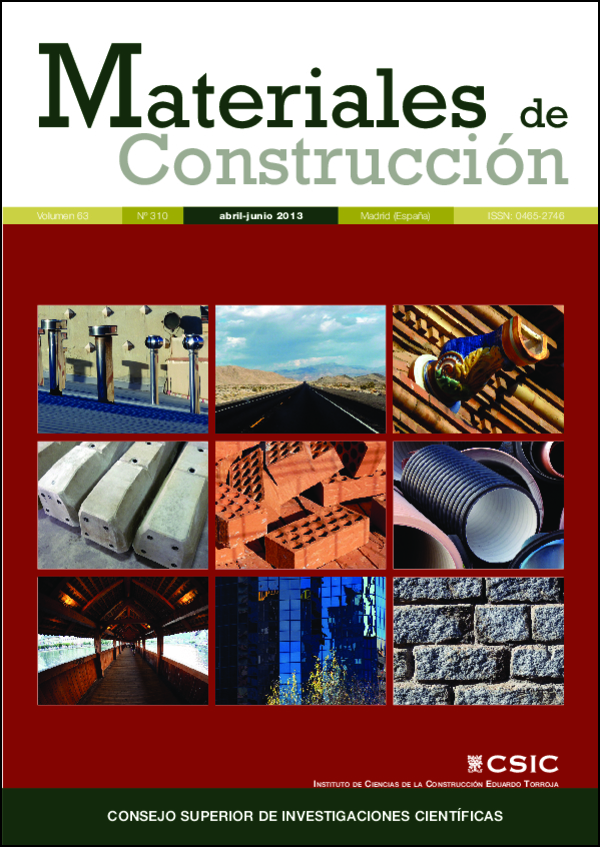Influence of the number of keys on the shear strength of post-tensioned dry joints
DOI:
https://doi.org/10.3989/mc.2013.07611Keywords:
dry joints, multiple-keyed joint, segmental structures, prestressed concrete, shear capacityAbstract
The shear strength of dry joints plays an important role in the design of prestressed segmental structures. However, the formulations of different design codes do not conform to the behavior of multiple-keyed joints. This paper ana - lyzes the fracture behavior of dry keyed joints under shear loading, focusing on the influence of the number of keys on the joint capacity and its average shear stress. It has been developed a finite element model of four different types of joints, with a number of keys varying between one and seven. The results show that the average shear stress transferred across the joint decreases with the number of keys but this effect is less appreciated as the prestressing stress increases. In this paper it is presented a formula of adjustment of the obtained numerical results including a factor with the dependence on the number of keys.
Downloads
References
(1) Turmo, J.; Ramos, G.; Aparicio, A. C.: "Resistencia de juntas secas conjugadas de puentes de dovelas prefabricadas de hormigón: propuesta para el Eurocódigo 2", Mater. Construcc. vol. 56, nº 282, pp. 45-52 (2006). http://dx.doi.org/10.3989/mc.2006.v56.i282.26
(2) Buyukozturk, O.; Bakhoum, M. M.; Beattie, S. M.: "Shear behavior of joints in precast concrete segmental bridges", Journal of structural engineering New York, N.Y., vol. 116, nº 12, pp. 3380-3401 (1989).
(3) Zhou, X.; Mickleborough, N.; Li, Z.: "Shear strength of joints in precast concrete segmental bridges", ACI Structural Journal, vol. 102, nº 1, pp. 3-11 (2005).
(4) Wakasa, T.; Otsuka, H.; Yabuki, W.: "Experimental study of the shear strength of precast segmental beams with external prestressing", Structural Concrete, vol. 6, nº 2, pp. 63-80 (2005). http://dx.doi.org/10.1680/stco.2005.6.2.63
(5) Turmo, J.; Ramos, G.; Aparicio, A. C.: "Shear strength of dry joints of concrete panels with and without steel fibres. Application to precast segmental bridges", Engineering Structures, vol. 28, nº 1, pp. 23-33 (2006). http://dx.doi.org/10.1016/j.engstruct.2005.07.001
(6) Issa, M. A.; Abdalla, H. A.: "Structural behavior of single key joints in precast concrete segmental bridges", Journal of Bridge Engineering, vol. 12, nº 3, pp. 315-324 (2007). http://dx.doi.org/10.1061/(ASCE)1084-0702(2007)12:3(315)
(7) Kaneko, Y.; Connor, J. J.; Triantafillou, T. C.; Leung, C. K.: "Fracture mechanics approach for failure of concrete shear key. I: theory", Journal of Engineering Mechanics, vol. 119, nº 4, pp. 681-700 (1993). http://dx.doi.org/10.1061/(ASCE)0733-9399(1993)119:4(681)
(8) Kaneko, Y.; Connor, J. J.; Triantafillou, T. C.; Leung, C. K.: "Fracture mechanics approach for failure of concrete shear key. II: verification", Journal of Engineering Mechanics, vol. 119, nº 4, pp. 701-719 (1993). http://dx.doi.org/10.1061/(ASCE)0733-9399(1993)119:4(701)
(9) Rombach, G.; Specker, A.: "Finite Element Analysis of Externally Prestressed Segmental Bridges", in Proceedings of the Fourteenth Engineering Mechanics Conference (EM 2000), Austin (2000).
(10) Turmo, J.; Ramos, G.; Aparicio, A. C.: "FEM modelling of unbonded post-tensioned segmental beams with dry joints", Engineering Structures, vol. 28, nº 13, pp. 1852-1863 (2006). doi:10.1016/j.engstruct.2006.03.028. http://dx.doi.org/10.1016/j.engstruct.2006.03.028
(11) Veletzos, M. J.; Restrepo, J. I.: "Modeling of jointed connections in segmental bridges", Journal of Bridge Engineering, vol. 16, nº 1, pp. 139-147 (2011). http://dx.doi.org/10.1061/(ASCE)BE.1943-5592.0000112
(12) ATEP: Proyecto y construcción de puentes y estructuras con pretensado exterior. H.P.10-96 vol. E-6. Madrid, Colegio de Ingenieros de Caminos, Canales y Puertos (1996).
(13) AASHTO: Guide Specifications for Design and Construction of Segmental Concrete Bridges, second ed., American Association of State Highway and Transportation Officials (1999).
(14) Rombach, G.: "Dry joint behavior of hollow box girder segmental bridges", in FIP Symposium "Segmental Construction in Concrete", New Delhi (2004).
(15) Bažant Z. P.; Oh B. H.: "Crack band theory for fracture of concrete" Materials and Structures, vol. 16, nº 3, pp. 155-177 (1983).
(16) Rots, J. G.; Blaauwendraad, J.: "Crack models for concrete: discrete or smeared? Fixed multi-directional or rotating?", Heron, vol. 34, nº 1, pp. 3-59 (1989).
(17) Cifuentes, H.: "Análisis del comportamiento en fractura y del efecto de borde en hormigones de altas prestaciones reforzados con fibras de polipropileno", PhD Thesis, Universidad de Sevilla, Escuela Superior de Ingenieros, Sevilla (2010).
(18) Abaqus Analysis User's Manual, Versión 6.9 ed., Abaqus, Dassault Systèmes Simulia Corp. (2009).
(19) Rombach, G.; Specker, A.; Zhou, X.; Mickleborough, N.; Li, Z.; Turmo, J.; Ramos, G.; Aparicio, Á. C.: "Discussion on 'Shear strength of joints in precast concrete segmental bridges'", ACI Structural Journal, vol. 102, nº 6, pp. 901-904 (2005).
Downloads
Published
How to Cite
Issue
Section
License
Copyright (c) 2013 Consejo Superior de Investigaciones Científicas (CSIC)

This work is licensed under a Creative Commons Attribution 4.0 International License.
© CSIC. Manuscripts published in both the print and online versions of this journal are the property of the Consejo Superior de Investigaciones Científicas, and quoting this source is a requirement for any partial or full reproduction.
All contents of this electronic edition, except where otherwise noted, are distributed under a Creative Commons Attribution 4.0 International (CC BY 4.0) licence. You may read the basic information and the legal text of the licence. The indication of the CC BY 4.0 licence must be expressly stated in this way when necessary.
Self-archiving in repositories, personal webpages or similar, of any version other than the final version of the work produced by the publisher, is not allowed.
















